The Golden Ring of Russia unites old Russian cities of five Oblasts – usually excluding Moscow – as a well-known theme-route. The grouping is centred northeast of the capital in what was the north-eastern part of ancient Rus'. The ring formerly comprised the region known as Zalesye. The idea of the route and the term was created in 1967 by Soviet historian and essayist Yuri Bychkov, who published in Sovetskaya Kultura in November–December 1967 a series of essays on the cities under the heading: "Golden Ring". Bychkov was one of the founders of ВООПИК: the All-Russian Society for the Protection of Monuments of History and Culture.
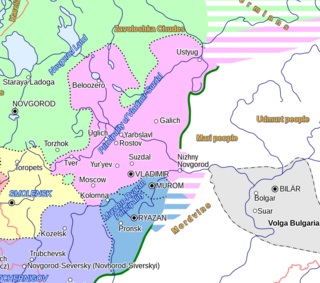
Vladimir-Suzdal, formally known as the Principality of Vladimir-Suzdal or Grand Principality of Vladimir (1157–1331), also as Vladimir-Suzdalian Rus', was one of the major principalities that succeeded Kievan Rus' in the late 12th century, centered in Vladimir-on-Klyazma. With time the principality grew into a grand principality divided into several smaller principalities. After being conquered by the Mongol Empire, the principality became a self-governed state headed by its own nobility. A governorship of principality, however, was prescribed by a jarlig issued from the Golden Horde to a Rurikid sovereign.
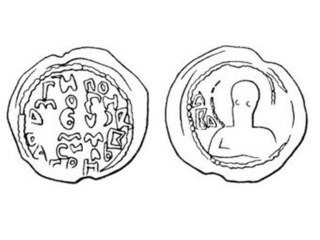
Vladimir II Monomakh was Grand Prince of Kiev from 1113 to 1125. He is considered a saint in the Eastern Orthodox Church and is celebrated on May 6.

Vladimir is a city and the administrative center of Vladimir Oblast, Russia, located on the Klyazma River, 200 kilometers (120 mi) east of Moscow. It is served by a railway and the M7 motorway. Population: 349,951 (2021 Census).

Suzdal is a town that serves as the administrative center of Suzdalsky District in Vladimir Oblast, Russia, which is located near the Kamenka River, 26 kilometers (16 mi) north of the city of Vladimir. Vladimir is the administrative center of the surrounding oblast. As of the 2021 Census, its population was 9,286.
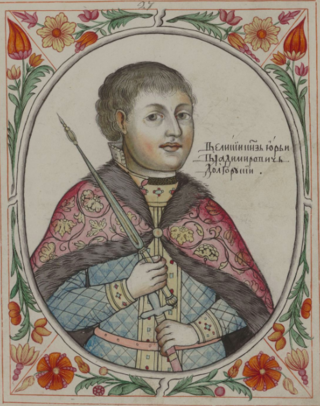
Yuri I Vladimirovich, commonly known as Yuri Dolgorukiy or the Long Arm was a Monomakhovichi prince of Rostov and Suzdal. Noted for successfully curbing the privileges of the landowning boyar class in Rostov-Suzdal and his ambitious building programme, Yuri transformed this principality into the independent power that would evolve into early modern Muscovy. Yuri Dolgorukiy was the founder of the Yurievichi dynasty, a branch of the Monomakhovichi.
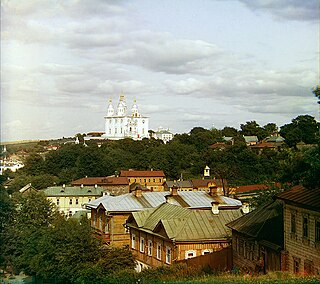
The Cathedral Church of the Dormition, dominating the city of Smolensk, Russia, from Cathedral Hill, has been the principal church of the Smolensk bishopric for 800 years.

The Cathedral of the Dormition, also known as the Assumption Cathedral or Cathedral of the Assumption, is a Russian Orthodox church dedicated to the Dormition of the Theotokos. It is located on the north side of Cathedral Square of the Moscow Kremlin in Russia, where a narrow alley separates the north from the Patriarch's Palace with the Twelve Apostles Church. Separately in the southwest, also separated by a narrow passage from the church, stands the Palace of Facets. The cathedral is regarded as the mother church of Muscovite Russia.

Andrew I, was Grand Prince of Vladimir from 1157 until his death. During repeated internecine wars between the princely clans, Andrey accompanied his father Yuri Dolgorukiy during a brief capture of Kiev in 1149; 20 years later, he led the Sack of Kiev (1169), and made efforts to elevate Vladimir on the Klyazma as the new capital of Kievan Rus'. He was canonized as a saint in the Russian Orthodox Church in 1702.

The architecture of Russia refers to the architecture of modern Russia as well as the architecture of both the original Kievan Rus', the Russian principalities, and Imperial Russia. Due to the geographical size of modern and Imperial Russia, it typically refers to architecture built in European Russia, as well as European influenced architecture in the conquered territories of the Empire.

The Church of the Intercession on the Nerl is a Russian Orthodox church and a symbol of medieval Russia. Dedicated to the Intercession of the Theotokos, the church is situated at the confluence of the Nerl and the Klyazma in Bogolyubovo, Vladimir Oblast, 13 km (8.1 mi) north-east of the ancient capital of Vladimir.

The Dormition Cathedral, also known as the Assumption Cathedral, is a Russian Orthodox church in Vladimir, Russia. It is regarded as the mother church of Russia through the 13th century. It is part of a World Heritage Site, the White Monuments of Vladimir and Suzdal.

The architecture of Kievan Rus' comes from the medieval state of Kievan Rus' which incorporated parts of what is now modern Ukraine, Russia, and Belarus, and was centered on Kiev and Novgorod. Its architecture is the earliest period of Russian and Ukrainian architecture, using the foundations of Byzantine culture but with great use of innovations and architectural features. Most remains are Russian Orthodox churches or parts of the gates and fortifications of cities.
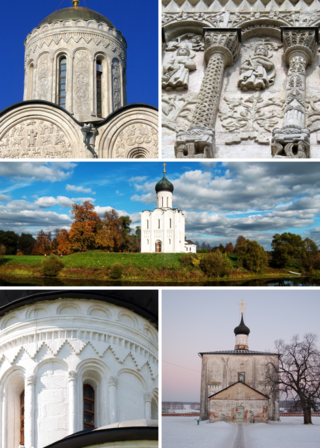
The White Monuments of Vladimir and Suzdal in Vladimir Oblast, Russia, have been designated as a UNESCO World Heritage Site. The patrimony embraces eight medieval limestone monuments of Zalesye from the late 12th and early 13th centuries. They include Russian Orthodox churches and a monastery, as well as a castle and gate:
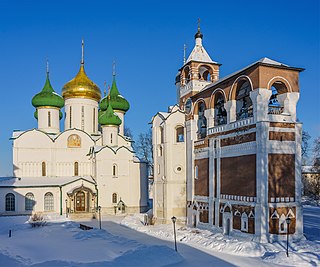
The Saviour Monastery of St. Euthymius is a monastery in Suzdal, Russia, founded in 1352.
The Prince of Pereyaslavl was the ruler of the Principality of Pereyaslavl, a lordship based on the city of Pereyaslavl on the Trubezh River, and straddling extensive territory to the east in what are now parts of Ukraine. It was situated on the southern frontier of Kievan Rus' and bordered the steppe.

Saint George Cathedral in Yuryev-Polsky is one of a dozen surviving white-stone churches which were built in Vladimir-Suzdal Principality in the northeastern Rus prior to the Mongol invasion. Constructed between 1230 and 1234, the cathedral was also the last of these churches to be built, completed just three years before the invasion. Unlike most of the other pre-Mongol Vladimir-Suzdal churches, the St. George Cathedral was not designated as the World Heritage site.

The Cathedral of Saint Demetrius is a cathedral in the ancient Russian city of Vladimir. It was finished in 1197 during the reign of the Grand Prince Vsevolod the Big Nest of Vladimir-Suzdal to the honour of Saint Demetrius of Thessaloniki. Being an important component of the White Monuments of Vladimir and Suzdal, the cathedral belongs to the World Heritage of UNESCO. Currently, the cathedral is a part of the Vladimir-Suzdal open-air museum.

The Vladimir Diocese is an eparchy of the Russian Orthodox Church centered in Vladimir Oblast, Russia. The main cathedral of the diocese is the Assumption Cathedral in the Cathedral Square of Vladimir.
Monomakhovichi or House of Monomakh was a major princely branch of the Rurikid dynasty, descendants of which managed to inherit many princely titles which originated in Kievan Rus'. The progenitor of the house is Vladimir II Monomakh. The name derived from the grandfather of Vladimir, Byzantine emperor Constantine IX Monomachos of the Monomachos family.























